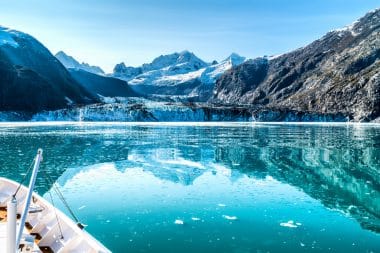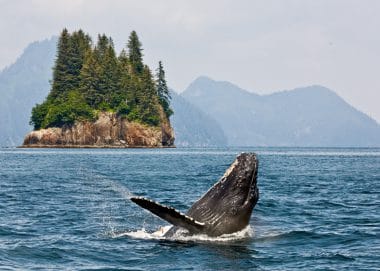In Alaska, the wilderness is majestic and partly still untouched. With two-thirds of the area under nature conservation, this is no wonder. Mountains, canyons, lakes, dense forests and glaciers line up in an impressive way. North America’s highest mountain is also located within the borders of Alaska. The fauna also flourishes in an impressive way and invites you to observe wildlife.
Despite the enormous size of the country, only about 730,000 people live in Alaska and about half of them in Anchorage. The capital Juneau, on the other hand, has only around 30,000 inhabitants.
Alaska is the largest state in North America, which is five times the size of Germany, and is divided into five regions with different landscapes and climates, with the south and the Alaska Panhandle being somewhat milder due to the proximity to the sea.
On average, however, 270 rainy days are expected per year.
In summer, temperatures range from 16° C to 32° C, although the temperature can drop to 4° C at night. Autumn is already clearly noticeable in August in these latitudes and the days become noticeably shorter. The winter is correspondingly cold with an average low of -13°C in January.
Alaska’s nature

Particularly impressive in Alaska are certainly fauna and flora. Both are still largely untouched and really wild. For nature lovers, the country is the ideal destination.
With 17 national parks, Alaska has more than any other U.S. state. Many of them were created between 1978 and 1980.
Above all, of course, when you think of Alaska, you think of bears, moose, eagles, otters, mountain goats, orcas and a variety of fish, especially salmon. A wilderness that is balanced, mutually regulating and also complementing each other.
Sea lions also perch on the rocks off the coast and are an impressive sight. They are also very interested in the annual salmon migration. More than 5000 salmon rivers lead from the sea to the interior of the country, where they are already awaited by bears, but also by anglers.
In summer, around 140 million seabirds also migrate to Alaska to take part in the summer feast, which consists primarily of mussels and limpets rather than fish.
Of course, friends of the ice are also catered for: the country’s 100,000 glaciers make up only 3% of the ground area, but are truly impressive. Many of them are home to stunning ice caves.
Alaska’s Cultures

The history of Alaska goes back a long way. About 10,000 to 16,000 years ago, the country was the first part of America to be settled by nomads from Asia who came over the Bering Bridge. It was not until the 17th century that the first Europeans came from Russia and in 1867 Alaska was purchased by the US government.
The official language in Alaska today is not only English, but also 20 indigenous American languages. According to the 2010 census, about 15% of the inhabitants have indigenous ancestry. Many of the indigenous people still maintain a traditional way of life and some of the settlements are also open to visitors.
It is important to the First Nations to preserve their culture and to inform about it.
At the Alaska Native Heritage Center in Anchorage, you can also get information about all indigenous cultures. A distinction is usually made between 5 main indigenous groups, which are divided according to the geography of the country.
Of course, the Russians have also left their mark on the country’s culture. Today, Russian is hardly spoken and there are almost no Russian institutions left in Alaska, but the church is Russia’s heritage. Today, about 50,000 people are still part of the Russian Orthodox Church. The Russian influence is also noticeable in the architecture of the churches with the onion domes. The services are often not only held in one language, but also different indigenous languages are used and even Christian songs are sung in Yupik or Tlingit, for example.
A trip to Alaska
The country can be a real eye-opener. But when the best time to travel is depends heavily on the preferences of the traveler. Summer from June to the end of August is undoubtedly the best time to enjoy nature. So if you are interested in bear-watching, kayak tours or fishing, it is best to go in the warm months. At the beginning of September, the trees finally turn in the strongest shades of red and yellow and the so-called Indian Summer begins. At this time it is exceptionally warm and dry, but the nights are already harbingers of winter.
From mid-February to about mid-April, Alaska is a paradise for skiing and dog sledding, and of course, don’t forget the tremendous beauty of the Northern Lights on these sun-poor days. Festivals can also be a special highlight. In October, Sitka hosts the Alaska Day Festival for three days, which commemorates the handover of the land to the United States and on Seward Day, which is always celebrated on the last Monday in March, the purchase of Alaska by the USA is celebrated and history is resurrected in several festivals throughout the country.
Between May and August, there are many other festivals, of which the Alaska State Fair is undoubtedly the largest, but there are also get-togethers in winter, such as the Fur Rendezvous Festival, which is dedicated to all the joys of winter.


